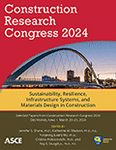Automated Underground Water Leakage Detection with Machine Learning Analysis of Satellite Imagery
Publication: Construction Research Congress 2024
ABSTRACT
Increasing water shortages, droughts, and global warming demand methods to rapidly detect underground water leaks. Conventional techniques are costly, time-consuming, and error-prone. However, remote sensing techniques can offer innovative solutions. Previous studies mostly used optical sensors. However, optical data has limitations, including noise interference, limited null subsurface penetration, and weather dependency. Therefore, the study in this paper aims at exploring the combination of radar satellite data and machine learning to automatically identify underground water leakages. Radar data offers sensitivity to soil moisture below the surface. Moreover, image texture features were leveraged from dual-polarized radar data to enhance prediction. Gray-level co-occurrence matrix texture features were combined with backscattering coefficients to create a feature space that could better train the random forest. Results indicate the ability to automatically detect 69% of underground leaks with subsurface moisture alone, which lists, tables, figures, display equations, footnotes, or references.
Get full access to this article
View all available purchase options and get full access to this chapter.
REFERENCES
Agapiou, A., D. D. Alexakis, K. Themistocleous, and D. G. Hadjimitsis. 2016. “Water leakage detection using remote sensing, field spectroscopy and GIS in semiarid areas of Cyprus.” Urban Water J., 13 (3): 221–231. https://doi.org/10.1080/1573062X.2014.975726.
Braun, A., and L. Veci. 2021. SENTINEL-1 Toolbox SAR Basics Tutorial. Esa.
Caballero, G. R., G. Platzeck, A. Pezzola, A. Casella, C. Winschel, S. S. Silva, E. Ludueña, N. Pasqualotto, and J. Delegido. 2020. “Assessment of multi-date sentinel-1 polarizations and GLCM texture features capacity for onion and sunflower classification in an irrigated valley: An object level approach.” Agronomy, 10 (6): 845. MDPI.
Chen, J., P. Tang, T. Rakstad, M. Patrick, and X. Zhou. 2020. “Augmenting a deep-learning algorithm with canal inspection knowledge for reliable water leak detection from multispectral satellite images.” Adv. Eng. Informatics, 46 (August): 101161. Elsevier. https://doi.org/10.1016/j.aei.2020.101161.
El-Zahab, S., and T. Zayed. 2019. “Leak detection in water distribution networks: an introductory overview.” Smart Water, 4 (1). Smart Water. https://doi.org/10.1186/s40713-019-0017-x.
Goutte, C., and E. Gaussier. 2005. “A probabilistic interpretation of precision, recall and F-score, with implication for evaluation.” Eur. Conf. Inf. Retr., 345–359. Springer.
Hanley, J. A., and B. J. McNeil. 1982. “The meaning and use of the area under a receiver operating characteristic (ROC) curve.” Radiology, 143 (1): 29–36.
Krapez, J. C., et al. 2022. “Multispectral Optical Remote Sensing for Water-Leak Detection.” Sensors, 22 (3). https://doi.org/10.3390/s22031057.
Long, D., and F. T. Ulaby. 2014. Microwave Radar and Radiometric Remote Sensing.
Mohanaiah, P., P. Sathyanarayana, and L. GuruKumar. 2013. “Image texture feature extraction using GLCM approach.” Int. J. Sci. Res. Publ., 3 (5): 1–5. Citeseer.
Pal, M. 2005. “Random forest classifier for remote sensing classification.” Int. J. Remote Sens., 26 (1): 217–222. Taylor & Francis.
Ranjbar, S., A. Zarei, M. Hasanlou, M. Akhoondzadeh, J. Amini, and M. Amani. 2021. “Machine learning inversion approach for soil parameters estimation over vegetated agricultural areas using a combination of water cloud model and calibrated integral equation model.” J. Appl. Remote Sens., 15 (1): 1–17. https://doi.org/10.1117/1.JRS.15.018503.
Traore, S., G. Fipps, C. Swanson, J. Dufek, and M. Robin. 2022. “Unmanned aerial vehicle system integrating high-resolution sensors for detecting leaks in irrigation canals—Proof of concept*.” Irrig. Drain., 71 (1): 206–217. https://doi.org/10.1002/ird.2641.
Information & Authors
Information
Published In
History
Published online: Mar 18, 2024
Authors
Metrics & Citations
Metrics
Citations
Download citation
If you have the appropriate software installed, you can download article citation data to the citation manager of your choice. Simply select your manager software from the list below and click Download.
